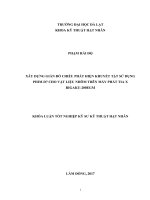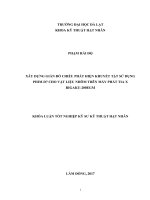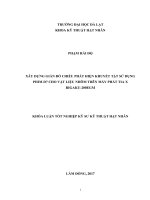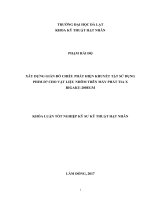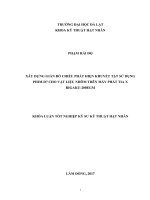Xây dựng giản đồ chiếu để chụp cổ vật bằng đồng trên máy phát tia X-Rigaku–200EGM
Bạn đang xem bản rút gọn của tài liệu. Xem và tải ngay bản đầy đủ của tài liệu tại đây (822 KB, 6 trang )
Tiểu ban D2: Ứng dụng kỹ thuật hạt nhân trong công nghiệp và các lĩnh vực khác
Section D2: Application of nuclear techniques in industries and others
XÂY DỰNG GIẢN ĐỒ CHIẾU ĐỂ CHỤP CỔ VẬT BẰNG ĐỒNG
TRÊN MÁY PHÁT TIA-X RIGAKU–200EGM
DEVELOPMENT OF EXPOSURE CHART FOR RIGAKU X-RAY GENERATOR- 200EGM
TO DETECT THE DEFECTS INSIDE BRONZE ANTIQUITIES
PHAM XUAN HAI, LE VAN NGOC, PHAM QUYNH GIANG.
Dalat Nuclear Research Institute, No 01 Nguyen Tu Luc Street, Dalat, Lamdong
Email:
Abstract: Non-Destructive Testing (NDT) techniques has been applied in the study of antiquities to check and detect the
defects such as cracks, porosity, slag inclusion, lack of fusion, lack of penetration in welds, delamination of materials, ...
without destroying them. When an X-ray generator is used for these tests, the image quality depends heavily on the ability
of X-rays to penetrate through the imaging materials. Therefore, it is important to determine the optimal exposure dose and
imaging parameters for each type of materials to achieve the best results. In this study, we developed the optimal exposure
chart for bronze materials on the Rigaku-200EGM X-ray generator. The obtained results will be applied in research on
defects inside bronze antiquities as well as in NDT research and training in the Training Center at Dalat Nuclear Research
Institute.
Keywords: No-destructive testing, defects inside antiquities, X-ray generator, exposure chart.
Tóm tắt: Ứng dụng kỹ thuật kiểm tra không phá hủy (Non-Destructive Testing - NDT) kiểm tra phát hiện các khuyết tật
như vết nứt, rỗ xé, ngậm xỉ, không ngấu, không thấu trong các mối hàn, tách lớp của vật liệu vật kiểm,… mà không làm tổn
hại đến chúng đã và đang được ứng dụng trong nghiên cứu cổ vật. Nếu sử dụng máy phát tia-X trong các kiểm tra này thì
chất lượng kiểm tra phụ thuộc nhiều vào khả năng xuyên sâu của tia-X qua các vật liệu chụp, vì vậy để xác định đúng liều
chiếu, chế độ chiếu chụp cho từng loại vật liệu trên từng máy chụp là rất quan trọng để có kết quả tốt nhất. Mục tiêu của
nghiên cứu này là xây dựng giản đồ chiếu tối ưu đối với vật liệu đồng có chiều dày từ 1mm đến 20mm trên máy phát tia-X
Rigaku-200EGM và thử nghiệm xác định khuyết tật của hai loại bức tượng đồng.
Từ khóa: Kiểm tra khơng phá hủy, khuyết tật bên trong cổ vật, máy phát tia X, giản đồ chiếu.
1. INTRODUCTION
In recent years, X-ray radiography has made an important contribution to archeology, which helps us
see the interior of an object and identify any invisible cracks or holes. Because of its availability, it can help
archaeologists and restorers in the historical restoration and preservation and contribute to the
dissemination of cultural information. The capabilities of an industrial X-ray generator depend on its
power, which depends on the maximum voltage of the generator. In radiography, the exposure dose of a
generator depends on voltage, amperage and exposure time. The voltage value determines the strength and
weakness of the emitted X-ray beam, which characterizes how deep the X-ray can penetrate through an
object. The product of the amperage and the exposure time determines the density of the emitted X-ray
beam, which characterizes the intensity of the X-ray beam. Therefore, an exposure chart is often built and
used.
RIGAKU – 200EGM X-ray generator is donated to the Training Center for teaching and scientific
research by Japan. To exploit the device effectively, it is very important to build exposure charts for
different types of materials according to different voltages. Based on the exposure chart, the radiographers
can easily select the necessary and optimal conditions for taking an X-ray of different objects. Bronze and
copper alloys are a common subject in radiography because they are relatively popular materials in welds
and castings [1].
Therefore, we built the exposure charts for bronze standard samples with the thickness range from
1mm to 20mm and voltages of 70kV, 80kV and 90kV.
2. EXPERIMENTAL
2.1. Experiment on RIGAKU X-Ray generator
Experiments to build exposure charts to determine the time and voltage suitable for different
thicknesses of materials were conducted on the RIGAKU-200EGM X-ray generator using Fuji #100 film
in the Training Center at the Nuclear Research Institute. Experiments in this study were only conducted in
478
Tuyển tập báo cáo Hội nghị Khoa học và Công nghệ hạt nhân toàn quốc lần thứ 14
Proceedings of Vietnam conference on nuclear science and technology VINANST-14
the laboratory and arranged based on the single-wall single-image technique.
X RIGAKU equipment was made in Japan with specifications as follows:
- Beryllium window ceramic X-ray tube (Beryllium thickness: 1mm).
- X-ray filter: Aluminum thickness: 2 mm (replaceable).
- X-ray tube output voltage: (70kV-200kV).
- The current of X-ray tube: 5mA.
- Effective target size: 2mm x 2mm.
The distance between the X-ray tube head and the sample varies from 50cm - 80cm and the
radiographing angle is 450. Therefore, we can easily change the voltage, distance, radiographing angle and
exposure time to meet the requirements for each sample. The X-ray tube is placed in a room with the
dimensions of 2.5m x 3.2m and is separated by a 20cm-thick concrete wall to ensure the radiation dose is
below the permissible level for the operators in the control room. The remaining surrounding walls are also
thick enough to ensure radiation protection with the dose rate less than 0.5µSv/h when the X-ray generator
is in operation. The dose rate at the operating position when the device is off is 0.14µSv/h.
2.2. Experimental arrangement for building exposure charts
Figure 1: Imaging sample and film
Figure 2: Bronze samples for examination
To construct the exposure charts, bronze reference samples with different thicknesses were used.
Each sample was imaged at 3 different voltages. The distance between the sample and the tube head was
changed to choose the right distance so that the film can achieve a density of 1.5-3.3, a sensitivity of 2% or
less, and a high contrast of 0.09-0.16. After choosing the right distance, samples were imaged with
different exposure times. Film after exposure was processed at the temperature of 20-220C to determine the
density. In this experiment, films with density D of 2 was selected to build the exposure chart. Figure 1
shows the layout of the sample, film and X-ray tube for single-wall, single-image technique. Figure 2
shows the bronze samples with the dimensions of 10cmx10cm, thickness from 1 mm to 20 mm [4].
2.3. Results obtained for voltages of 70kV, 80kV and 90kV
First, take some X-ray pictures to determine the suitable source-to-film distance (SFD) for the bronze
samples with a thickness of 1mm and exposure time of 6 seconds to achieve a density D of 2. This
experiment was conducted with the SFD of 50cm, 60cm, 70cm and 80cm. Exposure times for each SFD
distance were 6s, 12s, 18s and 24s respectively. Process the film at the temperature of 20 – 220C and
determine the density. The results after processing the film are given in Table 1.
Table 1: Exposure time, T(s) for bronze samples with different thickness and voltages
at the distance of 70 cm to obtain the density ( D) of 2.
Voltage
80kV
d (mm)
70kV
1
2
3.42
4.03
2.67
2.97
479
90kV
1.66
1.92
Tiểu ban D2: Ứng dụng kỹ thuật hạt nhân trong công nghiệp và các lĩnh vực khác
Section D2: Application of nuclear techniques in industries and others
3
4
5
6
7
8
9
10
11
12
13
14
15
16
17
18
19
20
4.59
4.95
5.68
6.29
7.30
7.95
9.20
10.19
11.26
12.84
14.88
16.65
18.61
21.45
24.31
27.26
30.67
34.48
3.17
3.81
4.34
4.91
5.50
6.28
7.07
8.11
9.39
10.78
11.47
13.59
15.06
17.45
19.83
22.30
25.69
28.41
2.48
2.81
2.88
3.39
4.07
4.39
5.22
6.04
6.63
7.44
8.43
9.86
10.79
12.89
14.34
16.53
18.56
21.24
From the obtained data, we built the exposure charts in Figure 3, 5 and 7 at the voltages of 70kV, 80kV
and 90kV with the distance of 50cm, 60cm, 70cm and 80cm and we obtained the desired density D of 2.The
distance of 70cm in agreement with the standards for density, sensitivity and contrast was selected for the next
experimental steps.
Experiment to determine the sensitivity was carried out by imaging samples of different thickness using
image quality indicators of the American Society for Testing Materials (ASTM). The measured data on the
processed film are shown in Figures 4, 6 and 8.
Select the IQI kit suitable for the sample thickness to achieve the best sensitivity less than 2% of the
sample thickness according to the radiographic standard.
Exposure time (s)
100
Sensitivity (%)
y = 3.0904e0.1205x
R² = 0.999
10
y = 0.013x3 + 0.282x2 - 2.520x + 10.75
R² = 0.981
1
0
5
10
15
Sample thickness (mm)
20
Figure 3: Exposure chart for bronze material at the voltage
of 70kV
Sample thickness
Figure 4: Sensitivity at the voltage of 70kV
R² = 0.999
sensitivity (%)
Exposure time (s)
y = 2.2846e0.1267x
y = -0.004x3 + 0.207x2 - 2.818x + 14.80
R² = 0.964
1
0
5
10
15
Sample thickness (mm)
20
Sample thickness(mm)
Figure 5: Exposure chart for bronze material at the voltage
of 80kV
480
Figure 6: Sensitivity at the voltage of 80kV
Tuyển tập báo cáo Hội nghị Khoa học và Công nghệ hạt nhân toàn quốc lần thứ 14
Proceedings of Vietnam conference on nuclear science and technology VINANST-14
y = 1.5619e0.1309x
Sensitivity (%)
Exposure time (s)
R² = 0.998
y = -0.006x3 + 0.273x2 - 3.837x + 18.89
R² = 0.977
1
0
5
10
15
Sample thickness (mm)
20
Sample thickness (mm)
Figure 7: Exposure chart for bronze material at the
voltage of 90kV
Figure 8: Sensitivity at the voltage of
90kV
100
70kV
80kv
90kV
Exposure time (s)
Phim
: Fuji# 100
Màn tăng cường : Màn chì 0.03 mm
10
1
0
5
10
Sample thickness (mm)
15
20
Figure 9: Exposure chart for bronze material at the voltage of 70 kV, 80 kV, and 90 kV, SFD = 70 cm.
The results of exposure time, sample thickness and voltage obtained at a fixed distance between the film
and the X-ray tube head are in agreement with the technical documentation of the generator in particular and the
radiographic method in general. From the obtained charts, the radiographers can easily determine the time,
distance and voltage for the bronze samples to be imaged with different thicknes when using Fuji #100 film.
Figure 10: X ray image of 2mm-thick bronze sample
at the voltage of 70kV; SFD = 70cm
Figure 11: X ray image of 2mm-thick bronze sample at the
voltage of 70kV; SFD = 70cm
481
Tiểu ban D2: Ứng dụng kỹ thuật hạt nhân trong công nghiệp và các lĩnh vực khác
Section D2: Application of nuclear techniques in industries and others
Figure 12A: Antique
bronze statue
Figure 12B: X ray image
of a bronze statue
Figure 13A: Antique bronze
statue
Figure 13B: X ray image
of a bronze statue
From the built-in exposure chart, tests were conducted to determine the defects inside two types of
bronze statues (Figure 12A and 13A) as well as the uniformity of the specimen (Figure 12B and 13B).
From the Figure 12B, we can see that the density of the statue is uniform and there are no defects inside the
statue. From Figure 13B, it can be seen that the different density of the statue means non-uniform
thickness. The head of the statue is thicker than the body; the body of the statue has cracks and porosities
inside.
2.4. Assessment of radiation dose and safety
To ensure radiation protection during the experiment, the dose rate distribution was checked and
evaluated during the operation. We used the Aloka TCS 172 dosimeter to measure the dose rate in the
generator area. The values of dose rates at different positions on the walls in room 1 shown in Figure 14
have been checked when the generator in operation at the maximum voltage of 200kV:
Figure 14: Diagram for dose rate (µSv/h) at different positions on the wall in room No1
when the X-ray generator is in operation at the maximum voltage of 200kV.
The obtained data on radiation dose rate inside and outside the X-ray room is quite low compared to current
Vietnamese standards for radiation protection, which is less than 0.5 μSv/h. The dose is 0.24 μSv/h at the operating seat.
2.5. Discussion
The obtained results of exposure time, sample thickness and voltage at fixed distance between film and tube
head are in agreement with the technical documentation of X-ray generator in particular and the X-ray radiography
method in general. Based on the results, the radiographers can easily determine the time, distance and voltage
value to be applied to the bronze samples to be imaged with different thickness when using Fuji #100 film.
The obtained exposure charts has been practically applied to check the bronze statues to determine their
defects and homogeneity as shown in Figure 12A. Based on the interpretation of the processed film, we can see
that the statue has an uneven thickness and the head of the statue is thicker than the body. There are cracks and
porosities in the body of the statue. The results give us an accurate assessment of the quality of the statue. From
Figure 13A, we can see that the density of the statue is uniform and there are no defects inside.
482
Tuyển tập báo cáo Hội nghị Khoa học và Công nghệ hạt nhân toàn quốc lần thứ 14
Proceedings of Vietnam conference on nuclear science and technology VINANST-14
3. CONCLUSION
The suitable exposure charts (time, voltage and distance) for bronze samples with thickness from
1mm to 20mm using RIGAKU–200EGM generator and Fuji film #100 is obtained in this study. The charts
also help students and trainees easily choose the optimal exposure conditions when practicing radiography.
In the future, we will build exposure charts at higher voltages for thicker bronze samples to be able to
exploit the device more and more effectively in training, research and development.
REFERENCES
[1] Baldev Raj, T. Jayakumar, M. Thavasimuthu. (1997). Practical nondestructive testing. Narosa Publishing house –
NewDelhi Madras Bombay Calcutta Lodon.
[2] Đao Quang Long, Nguyen Quang Hai. (1998). Material testing by level 2 radiographic technique. Vienna, IAEA
technical document.
[3] Norikazu OOKA, Toshihiro OHBA. (2007). Radiography testing. 1th VAEC-JAEA Joint Training Course on
Application of Nuclecar Technique in Industry and Environment.
[4] Training Center, Nuclear Research Institute. (2019). Experiment on industrical radiography, lecture and experimental
guidance.
483
